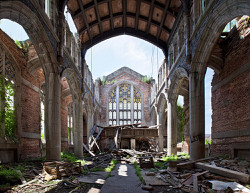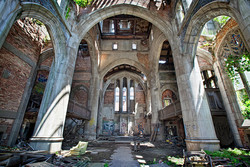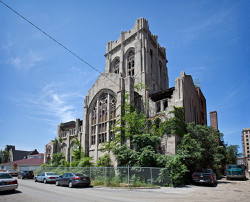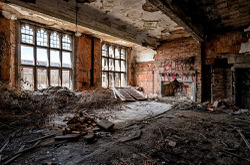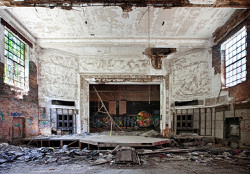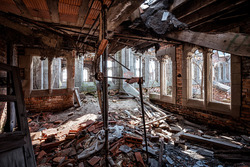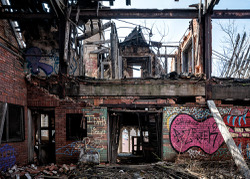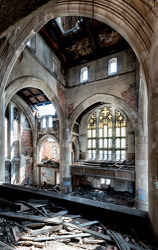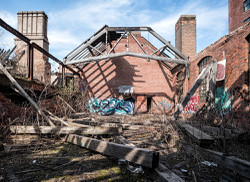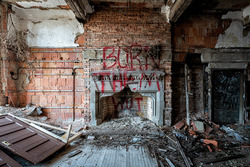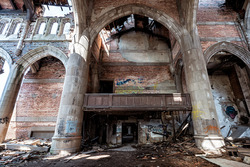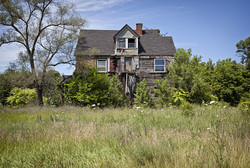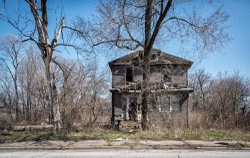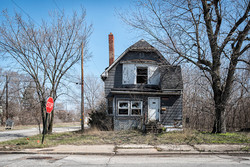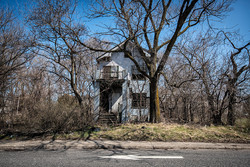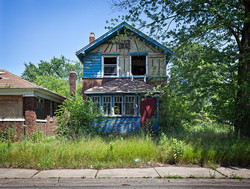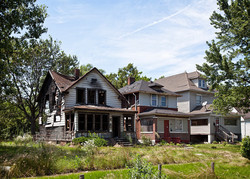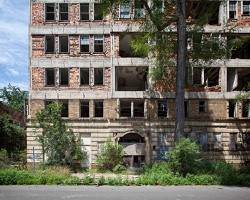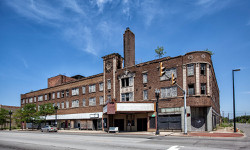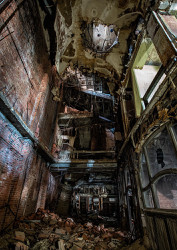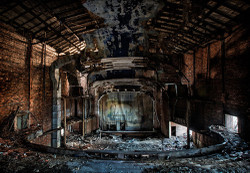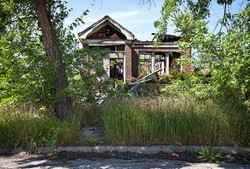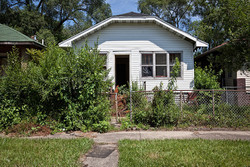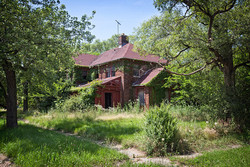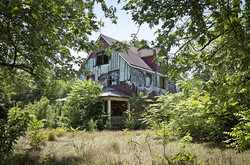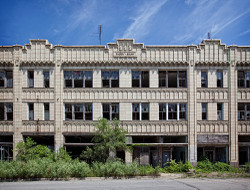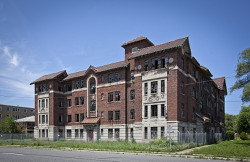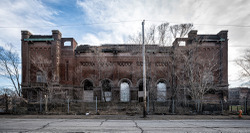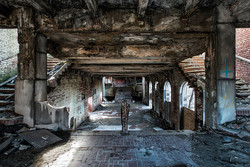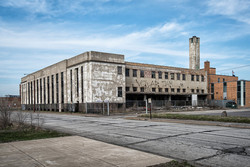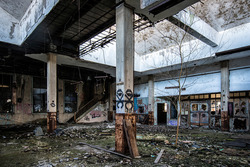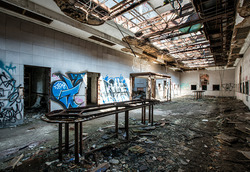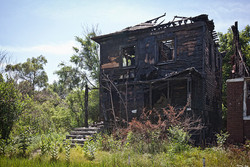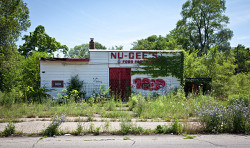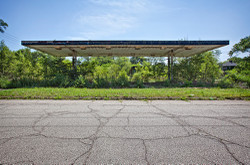Gary, Indiana
Updated February 21, 2023 | By Matthew Christopher
Emblematic of the changes in the American urban landscape that have doomed so many grand edifices, Gary’s present condition is a subject that I feel merits a great deal of consideration. Once dubbed “The City of the Century”, this metropolis earns the moniker - both in its ascent and its decline. In fairness, it is not at all accurate to label the city of Gary, Indiana itself as “abandoned”, as it is estimated that, as of 2014, approximately 78,000 people live there - yet at its peak in 1960 it had over 178,000 residents. This precipitous drop has led to a level of economic devastation that has left thousands of homes and buildings to rot. About 13,000 properties were considered blighted in a 2015 survey – over a third of the structures there. While many of the locations featured on my website are microcosms of the larger issues faced by their respective towns, the idea of attempting to chronicle the ruins of an entire city is daunting. Gary demands its own individual book to give a more complete idea of the scope of the architectural and civic loss.
One of the chief complaints leveled at those who explore modern ruins is that their work is exploitative, and it is not a criticism that is completely unfounded. Many consider neglected spaces to be fair game for idle consumption and entertainment, but they are often a crystallization of enormous losses suffered by real people – gravesites, if you will. One would (hopefully) not enter a community flattened by a tornado without an appropriate degree of respect, and yet the perception of ruins as playgrounds persists despite being borne of social shifts that are as destructive as any natural disaster, if not more so. The U.S. Census Bureau lists the median household income in Gary as only slightly over half the national average. Nearly 39% of its population lives at poverty level, and just over half of the population above the age of 16 works in the civilian labor force. These are sobering figures and ones I believe must not be forgotten when viewing the sad spectacle of the city’s decline. It must also be remembered that, as with any area in the throes of a crisis, there are people who are still proud of their town and who are still working to find a way to revive their neighborhoods. When a home is abandoned, there is a sense of sorrow as we confront the reflection of our own mortality; when viewing a city in which thousands of structures are abandoned, from homes to stores to churches to schools, my hope is that our empathy can stretch far enough to acknowledge that so many of the places the rest of us live in have been hit by similar losses in tent pole industries. Some areas were lucky enough to weather the storm; a frighteningly large number were not. I present my photographs not to besmirch Gary’s name or to encourage people to merely gawk at the doomed vestiges of its former greatness. I do so because I feel the remaining shadows pictured in this gallery deserve acknowledgment. Their passing is too momentous to be ignored.
The city that would become America’s largest company town was founded in the northwest corner of Indiana by U.S. Steel in 1906 and named after Judge Elbert H. Gary, who had cofounded the corporation with banking magnate J. P. Morgan five years earlier. After covertly purchasing almost 10,000 acres of swampland on the south shores of Lake Michigan, U.S. Steel immediately started construction of the sprawling Gary Works, enticing workers from across the country with the promise of jobs in the new, state-of-the-art mill. Even then, the town itself was an afterthought. The location was selected more for its proximity to shipping routes and railways than any idealistic vision about the quality of life that would be provided there. Nevertheless, as thousands of laborers poured in, the city blossomed. Notable architects across the country designed domiciles, churches, and civic buildings. It would be easy to call the decades that followed Gary’s glory days, but like any factory-built and -owned town, it was rife with corruption and economic disparity from the beginning. As the sparkling downtown was built, the deep undercurrent of bigotry that would one day prove a part of its undoing was becoming more problematic. European immigrants and Blacks fleeing the Jim Crow laws in the south were flocking to the city, much to the chagrin of Indiana’s Ku Klux Klan members, whose ranks dwarfed those in other northern states. The segregation and inequality that plagued the rest of the nation caused a deep schism in Gary, one that would ultimately tear it in half. As Black residents moved into other areas outside the Midtown section of Gary, they were confronted with threats and violence, despite the fact that by the 1950s they constituted a third of U.S. Steel’s workforce in the city.
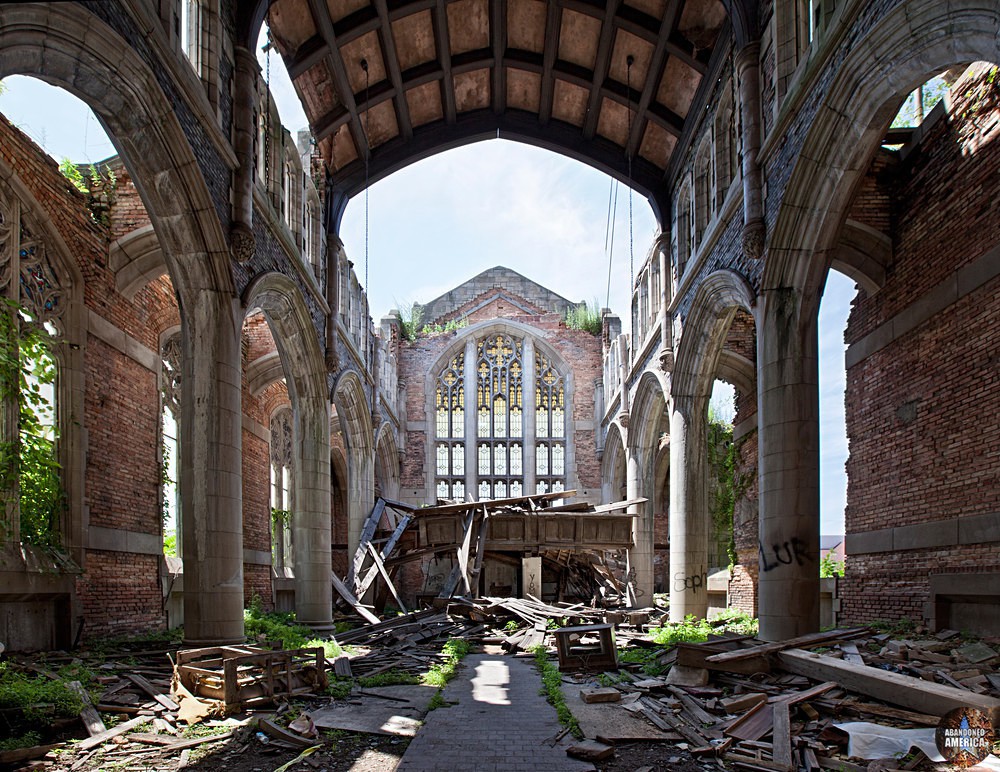
City Methodist Church is perhaps Gary, Indiana's most iconic abandoned site.
Driving through the downtown, it’s hard to fathom what could have gone so wrong that it convinced so many of the people who lived here to leave a city full of such breathtaking buildings behind. One of the city’s most iconic ruins is the City Methodist Church, the vision of Dr. Grant Seaman, who convinced Judge Elbert H. Gary not only to arrange for a matching donation of close to $400,000 in funds towards its construction, but also to personally provide a Skinner organ. An attached fellowship center, named Seaman Hall, once housed a gymnasium, a 1,000-seat theater capable of hosting world-class plays as well as films, a banquet hall, gardens, and classrooms. The nine story English Gothic church was completed in 1926 and a year later had a congregation of 1,700. Budget woes caused by high maintenance costs beset the house of worship early on, but Seaman’s progressive approach to the city’s segregation issues also caused friction with his parishioners. Though his congregation was opposed to racial integration, Seaman held joint services with a nearby Black Methodist church, petitioned for Black patients to be admitted to the Methodist Hospital, and spoke out against the screening of the wildly prejudiced cinematic paean to the KKK, The Birth of a Nation, at the nearby Orpheum Theatre. His fears were not unfounded. Two years before City Methodist’s dedication a young Black man was doused in gasoline and set on fire by white assailants who were never caught; assaults on Gary’s minority citizens were a constant threat. Seaman’s beliefs rankled members of the congregation, and they had him transferred against his wishes to a church in Ohio only three years after the church opened. Dr. Seaman, once nicknamed “Sunny Jim” for his charisma and optimism, died in a car accident in 1944. He was reunited with his church once more when his ashes were interred in the sanctuary. Membership peaked at 3,000 in the 1950s, but by the time of its closure in 1973 had waned to only 320 congregants, many of which didn’t even regularly attend services. The rooftop garden Seaman had hoped would crown his greatest achievement didn’t materialize until years after the devastating downtown fire in 1997 when the third floor gymnasium’s ceiling collapsed and trees began to grow in the rubble.
The exodus from the downtown that ultimately condemned the church was in part due to mounting unrest. By 1950, Gary was one of the most segregated cities in the United States and it was becoming glaringly apparent that the double standards for its citizens could not last. Strikes and protests were increasingly frequent, and overseas competition in the steel industry brought about layoffs that rocked the town’s economy, causing the crime rate to rise. Nearby towns such as Merrillville attracted middle class residents and built shopping centers that directly challenged the stores on Broadway, the main thoroughfare in Gary that shoppers had once traveled from across the state to visit. Throughout the United States, urban living was losing its allure as those who could afford to do so migrated to the suburbs; as businesses followed them it created a self-perpetuating cycle. The less money cities had, the less desirable they became to those with the money, and their exodus in turn increased the privations that drove them away.
In 1968 Gary’s residents elected one of the civil rights movement’s rising stars, Richard Hatcher, as its mayor. Hatcher, 34 at the time, was the first African-American mayor of an American city with more than 100,000 people, and had appeared alongside luminaries like Robert F. Kennedy, Martin Luther King Jr., and Jesse Jackson at rallies. His tenure as the city’s mayor lasted nearly two decades, during which Gary’s economy plummeted. While many blame him for the city’s woes, the decline of the steelmaking industry that ravaged the city was by no means isolated to Gary or even Indiana. James Ciment writes in Postwar America: An Encyclopedia of Social, Political, Cultural, and Economic History, “During its capacity-building phase in the 1950s, the steel industry had largely invested in outdated flat-rolled mills, a technology that dated back to the early twentieth century. Meanwhile, overseas competitors in Europe and Japan – which, because of wartime destruction, were forced to build their steel industries from the ground up – had invested in far more efficient integrated mills, allowing them to undersell U.S. producers by as much as 20 percent in the late 1960s.” By comparison, Bethlehem Steel’s plants in Lackawanna, New York, and Bethlehem, Pennsylvania, were also faltering in the 1970s, as was the Homestead Steel Works in Pittsburgh.
The effects of mergers and plant closures rippled across the rust belt, knocking out ancillary industries and the towns that depended on them. Unlike many mills, Gary Works continued to operate, but with a dramatically reduced workforce – where it provided 30,000 jobs in the 1970s, the number had shrunk to 6,000 by the 1990s. In the mid 1980s, the National Tube Division in Gary closed, followed by the Gary Screw and Bolt Company. The city was hemorrhaging jobs in a downsizing process that continues even now; U.S. Steel closed its coke plant at Gary Works in 2015, laying off an additional 323 workers. According to the related article in the NWI Times, which serves Northwest Indiana, U.S. Steel laid off 6,000 workers nationwide just that year. The article was only printed in April.
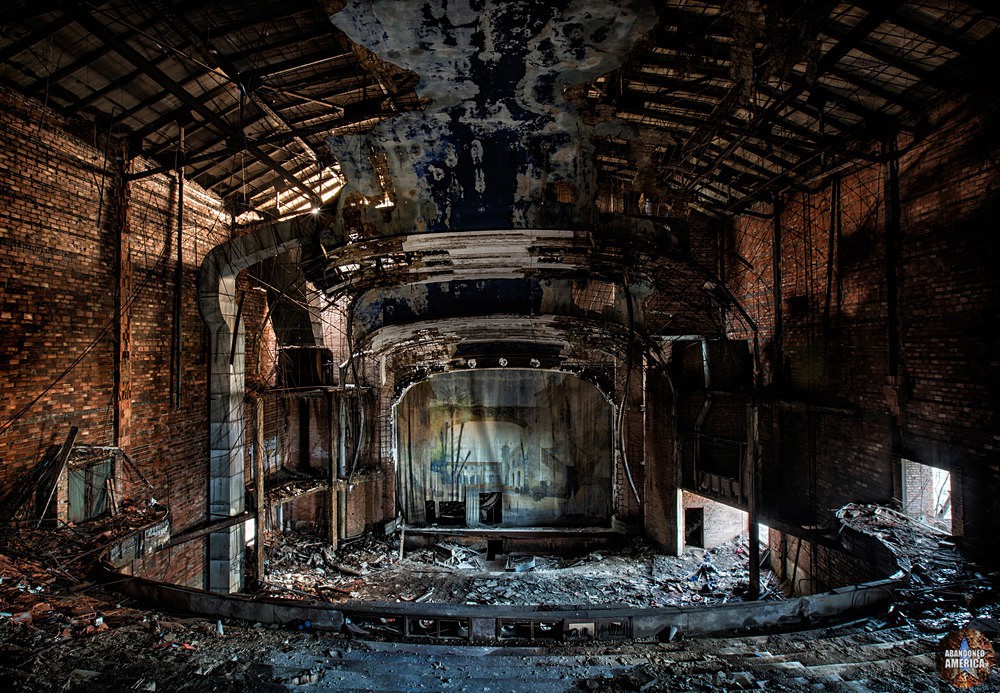
The remains of the Palace Theatre in Gary, Indiana
During his years in office, Hatcher worked to secure federal funding to combat poverty and crime, but it must have felt like trying to plug leaks in a foundering dam with his fingers. The business district was left in tatters. One of Broadway’s crown jewels, The Palace Theatre, still remains as a grim memorial of better days. Opened in 1925 and composed as a Spanish castle complete with Greek and Roman statues and imported chandeliers, The Palace could accommodate 3,000 patrons. Initially its fare consisted of vaudeville acts but in 1930 the theater switched to film. A few years before it closed in 1972, a man was stabbed in the lobby; Matt Lambros writes in After the Final Curtain, “It reopened three years later as the Star Palace Theatre, but closed again when the owner could not afford to pay the utility bills. In 1976 it reopened for the final time as the Star Academy of Performing Arts and Sciences, but shuttered soon after when funds from a government grant used to reopen ran out.” Little of its finery remains, although the pale likeness of a Spanish villa is still visible on the worn curtain hanging over the stage. The lobby is now shrouded in darkness, its vaulted ceiling towering three floors above a large pile of bricks that fell from it. Like many other lost landmarks, it’s hard to imagine what it must have been like when it was in its heyday. There are traces if you look hard enough, like the wooden railings or the graceful curves in the windows that separate the lobby from the theater.
Other buildings, like the Art Deco post office building constructed in 1936, have been vandalized to the point where their original character is nearly indistinguishable. Closed in the 1970s, it was built as part of President Franklin Roosevelt’s New Deal program and designed by Howard Lovewell Cheney, the architect behind Washington National Airport. Though the superstructure is intact, the interior features have been smashed or stripped away to the point that determining what areas were used for is largely guesswork. During my visit, a small crowd of twenty-somethings flocked around a young lady modeling at the base of a lone tree inside the post office’s sorting area, posting photographs to Instagram and chatting happily. It seemed an odd juxtaposition to me, particularly since I am so used to abandoned places being empty, but it marks a shift in the visitors who come to Gary now; at one time they might have been patronizing Goldblatt’s, Sears and Roebuck, or Kresge’s downtown, but now they are coming to take selfies amid the fragments of Gary’s vanishing identity. With a resigned acknowledgment of the draw of disaster tourism, for a time the city of Gary was charging visiting photographers $50 for a permit to shoot abandoned buildings, but even this initiative seems to have evaporated. There was also talk of turning City Methodist into a ruin garden such as the ones found in Europe, which I consider a fantastic idea, although I am unsure how they’d manage the concerns of legal liability if someone was injured by some calamity such as a collapsing wall.
There are also stories, which I have been unable to corroborate, of out of town photographers being robbed at gunpoint in the ruins, which is something I have also heard rumors of at the Packard plant in Detroit. Indeed, the crime rate in Gary was so high that in the 1993 it earned the dubious distinction of being the “murder capital of the U.S.”, with a murder rate of 91 per 100,000 people– three times that of Chicago. The issue does not seem to have improved much. Despite efforts by officials to curb lawlessness, Gary’s violent crime rates are still comparable to other notably unsafe cities like Camden, New Jersey. Compounding the problem, in 2015 alone over two dozen police officers left Gary’s police force for jobs in other communities that paid better and were less risky. In a real life horror story that particularly stands out to someone who explores deserted buildings, serial killer Darren Deon Vann was arrested in 2014 for murdering local women and hiding their bodies in abandoned houses throughout the town. Though seven bodies have been found, there is a chance that more are still out there. The mind-bending volume of derelict homes means there are many places left to look.
The lifeless façades dotting the town dare one to try to mentally reconstruct them; the Parry-Shaw building, built in 1926, still has the beautiful arcade of lancet arches and terra cotta mullions separating the windows, but barely any traces of the apartments or retail spaces that once occupied it are left. The front lobby section of the Gary Public Schools Memorial Auditorium, where the Jackson Five won one of their early hometown talent shows, is all that is left of the massive 5,000-seat Mission/Spanish Revival monument to those killed in World War I. It opened in 1927, only a year after City Methodist, and was a center for many of the city’s cultural and athletic events as well as hosting noteworthy guests such as President Harry Truman and Frank Sinatra. The majority of the building was destroyed in the downtown fire of 1997. Now, collapsed concrete staircases on one end of the remaining structure dare trespassers to try their luck with those on the other side. The trip isn’t worth it. Whatever noteworthy features that once adorned the interior are gone, leaving only the exterior’s brick and terra cotta veneer emblazoned with the words ART, MUSIC, and ATHLETICS to remind you that once this place had once been their home.
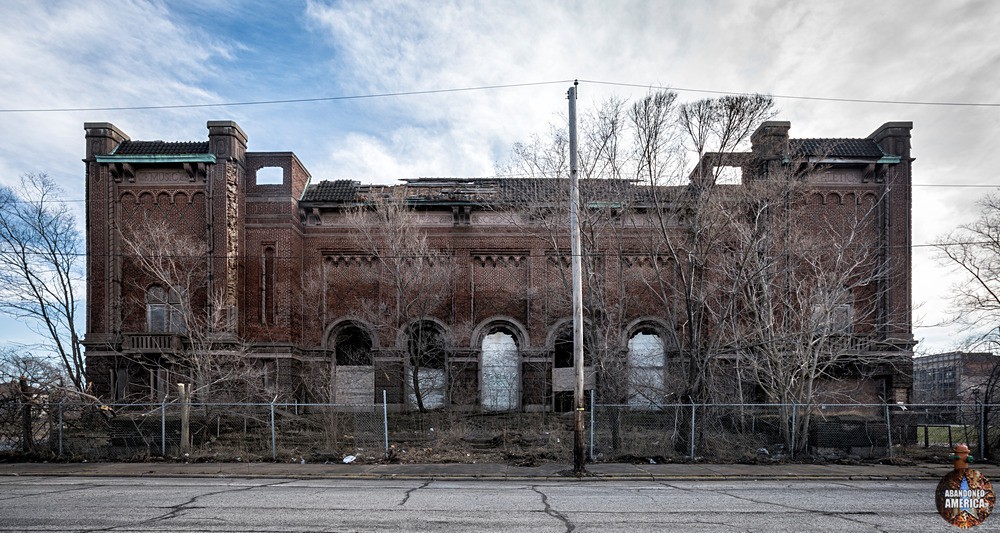
Little is left of the Gary Public Schools Memorial Auditorium
The question I found myself coming back to, again and again, was “What was the dream that built Gary?” It is different depending on who you ask. U.S. Steel was clearly there to make money, and for better or worse that continues to be its primary goal. For the residents who migrated there from across the globe, many of whom were doing so to escape persecution elsewhere, the answer was much more relatable: they came in search of jobs, a safe community, opportunity, equality – things that are scarce commodities in Gary today.
There is typically something awe-inspiring about ruins, but there was nothing rapturous about the derelict parts of the town to me. Wandering about these tombs, I usually feel am where I belong: my home amongst the dead… but there has always been that part of me that desperately needs life to come back to. I wished I knew how to change the stark reality of the blocks upon blocks of such palpable loss around me. This architectural carnage was not a result of progress but rather an injustice so deep that it seems it can never be repaired - but it demands the effort. In one of the many closed school buildings that were once the pride of the city, I paused for quite some time at a bulletin board covered with fading photographs of the smiling young faces of the students who had gone there. Didn’t these children deserve a more economically stable future? City officials and nonprofit groups are working at it, tearing down abandoned houses, creating community gardens, and putting together volunteer crews to clean streets. The problems they are addressing are not easy ones to solve, and I admire their determination in tackling them. They deserve success.
At one point when I approached the burned-out husk of a home to photograph it I saw a young couple watching me from across the street – would they call the police, I wondered? Being an outsider, the stories I’d heard of out of town photographers being robbed crossed my mind also. Instead, they smiled and waved at me, and continued on their way. I didn’t meet a single resident of the town who was anything less than kind and welcoming. That’s not to say that crime statistics should be ignored, but like any other American city I believe the majority of people are kind and would help a stranger out if they were in need. That truth can’t be forgotten or ignored.
I wish I could have witnessed Gary during brighter days, when I might have visited the stores on Broadway or watched a movie at the Palace Theatre - just as I wish I could pull places like the SS United States or Long Beach back to the land of the living. These spaces are haunted not by phantoms but by the accomplishments and struggles of those who have passed before us dissolving into obscurity. I‘m always chasing their echoes but never quite manage to hear their song. My own inability to heal the wounds I so studiously catalogue stares back at me from every image. All I have to address them with are my photographs and my words, and neither ever seem to be enough.
👉 Join Abandoned America on Patreon for high quality photos & exclusive content
👉 Make a one-time donation to help keep the project going
👉 Listen to the new Abandoned America podcast
👉 Subscribe to our mailing list for news and updates

